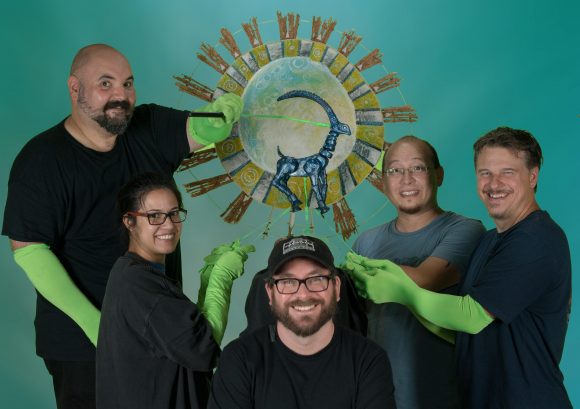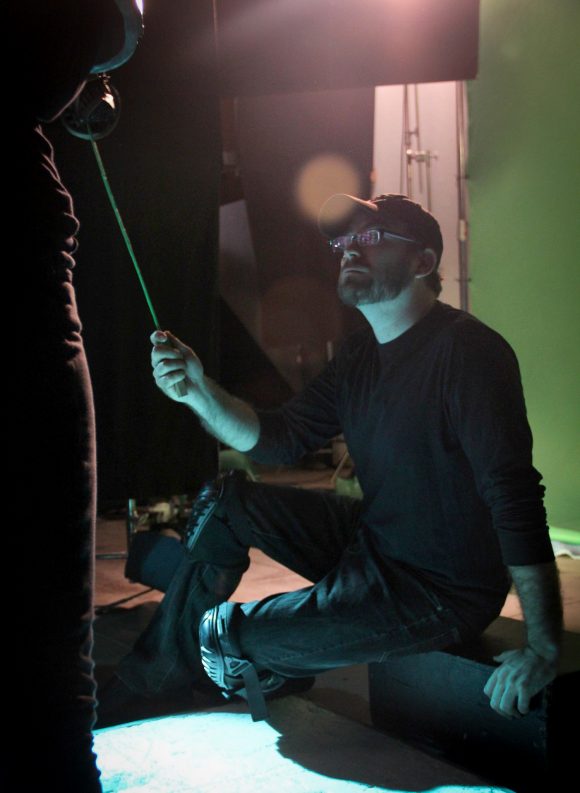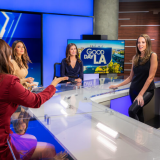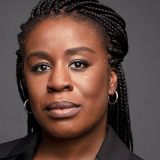
Ever Wanted to Work with Puppets? Alumni Spotlight: Alex U. Griffin '13
March 10, 2023
Dodge alum Alex U. Griffin has taken quite the unique path in the film industry after graduating from Chapman University in 2013 with his MFA in Film Production. We got the chance to interview him about his career in filmmaking and puppetry arts and how being in Chapman’s graduate program helped him along the way.

How did you first get involved in puppetry?
It all started with my mother skinny-dipping! I was in high school and my family had just moved from a larger city to small-town Iowa, and my mother was skinny-dipping with some old friends and noted my adjustment woes. Somebody recommended taking a class with Le Mutt + Friends toy designer Francesca Hoerlein, who had just studied television puppetry techniques with a number of Muppeteers. While I initially didn’t have interest, I agreed to attend the first (free) class… and it took about thirty seconds until I was hooked!
My family was living in poverty, so I made an arrangement with Francesca to do odd jobs in exchange for the remaining classes. Though we soon started to work together as collaborators, with myself often running the camera and technical side of things on top of performing. In my senior year of high school, I used Francesca’s camera and puppets to create a bicycle safety video as my Eagle Scout project, which was used in the local school system for a number of years afterward.
While Francesca taught me monitor puppetry (in the style that Jane and Jim Henson helped refine with The Muppets), she also helped set me up to attend the National Puppetry Conference at the Eugene O’Neill Theater Center. It was working there with Marty Robinson where my mind began expanding to genuinely include the greater world of puppetry arts, its varied forms and applications, and its continued importance in both theater and film.
For example… folks are often surprised to realize that aside from characters more heavily marketed as puppets in content like The Dark Crystal or Team America World Police, film and TV characters like Star Wars’ BB-8 and Grogu (Baby Yoda) are puppets, as is a chunk of the dinosaur work in the Jurassic Park/World movies, and in many instances where filmmakers desire a relief from, or a more nuanced/relatable character than, a potential fully-animated or CGI counterpart. And then there are puppets that are manipulated by animators instead of being performed by a puppeteer, like in Coraline or Guillermo del Toro’s Pinocchio (which just won the Academy Award for best animated film), yet have a lot of overlap in the creative behind-the-scenes talent and way we perceive it all.
It brings me much joy to be able to hone my performance and filmmaking talents into helping push the practical, the “real,” within often creative and innovative films, and I am very grateful to everybody who has helped me along the way.”
As a puppeteer, who inspires your craft the most?
I inherently struggle with questions like this as I feel there are so many people who have given me inspiration in so many ways. Like filmmaking, it’s a culmination of art and inspiration from everybody involved.
If I have to name puppetry inspirations for me growing up, I feel like Sheri Lewis, Fred Rogers, and Jane and Jim Henson would be the top contenders. They all created puppetry art, on screen, that was both creative and inspiring on a multitude of levels.
Jim Henson also lands as a big inspiration to me as a filmmaker in general, as many of his films (like the Academy Award-nominated short film Timepiece) have a genuine innovation and creative approach that is often hard to find. And with that as a base I’ve been fortunate to explore not only cinematography and filmmaking itself, but also the greater world of what puppetry can do on film, and find countless continued inspirations within that.

Jim Henson and the Henson Family name remain synonymous with the craft of puppetry. What’s it like working as a producer with Heather Henson on the Handmade Puppet Dreams film series?
It’s been wonderful. I came in under then-producer Sam Koji Hale (for whom I was also Director of Photography for his all-puppet feature film Yamasong: March of the Hollows), as the intentionally-ambiguously-titled Film Coordinator. After Sam moved over to Nickelodeon to work on the show Big Nate, I stepped into the role of producer.
The Handmade Puppet Dreams film series itself is a branch of Heather Henson’s nonprofit Green Feather Foundation (formerly IBEX Puppetry), and has the mission of promoting independent artists to explore their handmade craft specifically for the screen. All of our films focus on real-time puppetry, helping to give a voice to a medium that struggles categorically as it’s not quite live-action in the way many think of it, yet not quite traditional animation either.
Within this series alone, I’ve had the opportunity to be a freelance cinematographer/editor/additional puppeteer within five short films for commissioned artists (hired independently), director/cinematographer/editor for twelve Filmmaker Spotlight documentary shorts, and a co-producer for twenty-one films. I also do graphic design and illustrations for the company. This year I will be also directing my own puppetry short for the series (fulfilling a commission granted before I became producer), which will be a fun yet contemplative western titled The Man with No Face.
 You’ve mentored under some incredible names such as Marty Robinson (Sesame Street), Richard Termine (The Muppets), and Ronnie Burkett (The Daisy Theatre). What’s the best piece of advice you’ve received from your mentorships?
You’ve mentored under some incredible names such as Marty Robinson (Sesame Street), Richard Termine (The Muppets), and Ronnie Burkett (The Daisy Theatre). What’s the best piece of advice you’ve received from your mentorships?
I have received so many wonderful pieces of advice and guidance from all of them, especially Ronnie Burkett, who is always willing to challenge people to exit their comfort zone and explore what awaits them there.
Though one of the more influential pieces of advice I’ve received and often share with others came from cinematographer, Chapman professor, and mentor Johnny Jensen. During one of our meetings after I’d graduated, he said “If you can keep the spark that brought you [to film school] to begin with, you’ll be just fine.”
The longer I work, the more I find that sentiment true. I feel like so many of my successes have been allowed to happen because I continue to keep a spark, an enthusiasm, and a want to learn with an open mind and explore what’s possible within the given limitations of any production. And I feel that for anybody who brings that sort of spark to a project, the project will often be better for it.
Given your MFA in film production and cinematography experience, does your film production background and education intermix with your puppetry work?
Completely! I was already an experienced puppeteer before coming to Chapman, and came with the idea that I was essentially re-focusing my career into filmmaking itself. Though…
In my first semester, we had a special class at Mole Richardson with Isidore Mankofsky, who was the cinematographer for both The Muppet Movie (1979) and the short puppet film Too Loud a Solitude (2008), which amazingly enough had been commissioned as part of the Handmade Puppet Dreams film series before I even knew what it was. My professor, Jürg Walther, had shown him my puppetry reel ahead of time, and Isidore was wonderful enough to spend part of the class having a one-on-one meeting with me to talk about the magic of, and complications within, working with puppetry. I feel that was instrumental in my opening up to pursuing the worlds of puppetry and filmmaking combined.
When filming puppetry, every shot is a special effects shot. You have to create a compelling image and hit all the needed storytelling beats while filming and editing around a potential gang of performers and their bodies under/over/beside every single character. And that’s not to mention rigging sets, props, and having to light around all of this. While making it still look natural, of course!
I often refer to it as a “dance.” The experience of dancing that dance, and the constant problem-solving needed, has been extraordinarily helpful when approaching any project, whether it features puppetry or not. You learn to make small adjustments that can have huge impacts, which I feel can help any filmmaking project looking to maximize what it can offer.

Your films have played at festivals around the world, including Cannes, Slamdance, and more. Do you have any specific film or career milestones you’re most proud of?
I feel like I’ve had a number of milestones that I’m very proud of, though a few that stand out at the moment are… being a cinematographer and puppeteer for the all-puppet feature film Yamasong: March of the Hollows, being part of The Gaze editorial team under Chapman alum and beloved friend Angelica Robinson as producer (which earned me an Emmy nomination), serving as President and Vice President for the non-profit organization Puppeteers of America, working with Chapman alum Iz Gutierrez as cinematographer for the historical drama They Call Us Sediciosos, producing and hosting the 48hr Puppet Film Project, and pretty much everything I’ve been able to accomplish, and those I’ve been able to help inspire, within Heather Henson’s Handmade Puppet Dreams film series.
At this very particular moment in time, one of my more enjoyable recent freelance gigs (that I can speak of, at least) was working with segment director Adrian Rose Leonard to film marionette puppetry segments for the feature documentary Louder Than You Think. The film, directed in whole by Jed Rosenberg, was named as one of Rolling Stone’s most anticipated films at SXSW and recently premiered to positive reviews.
If you were a puppet, what kind of puppet would you be?
I would most likely be a Bunraku-style table-top puppet, as I feel like so much of what I do (and what I can do) is the culmination of the often skilled people and influences around me all coming together to allow, support, and help move my personal character and story along.
Want to keep up with Alex on his next endeavors? Follow him on Instagram @alexugriffin or stay connected through his website www.alexugriffin.com or by email at alex.u.griffin@gmail.com. Learn more about Alex’s work as a producer on Heather Henson’s Handmade Puppet Dreams film series by visiting www.handmadepuppetdreams.com.


